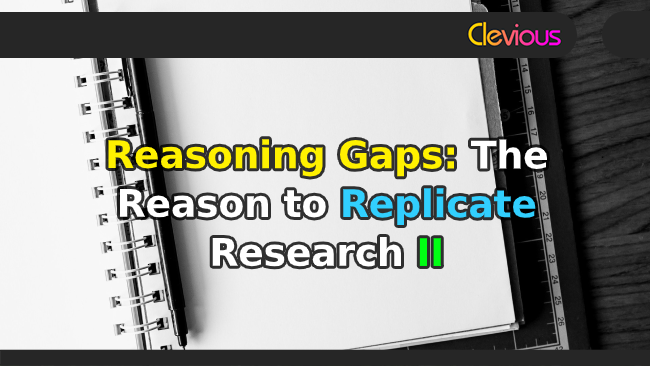Reasoning Gaps: The Reason to Replicate Research II
In this second part of The Reason to Replicate Research, I’m going to develop with more details and explanations the Reasoning Gaps idea I briefly discussed in the article “How to Come Up with Research Question Easily Like a Pro”.
And just like in Part I, I will try to pivot the explanation around an example and show why they are important to fill.
What Does A Research Gap Stand for?
A research gap is, in general, any scientific problem you encounter in a scientific article, academic book, or a thesis. The problem you encounter in the literature can be remedied with the development of new research that addresses that particular issue.
In the first article above, based on Anthony Miles’ Taxonomy of research gaps, I summarized the 7 gaps he noted into three main categories namely: theoretical gaps, empirical gaps, and reasoning gaps.
What Are the Reasoning Gaps?
Because humans are not 100% logical — and if they literally do, they behave like a machine and as a result fail other aspects of reality such as meaning — reasoning gaps are a logical and a natural consequence of human life.
The tensions between logic (Ensuring the relations between premises and conclusions, etc.), the uncertainties of meaning (The limits of interpretation, etc.), and how a researcher manipulates them (Through his knowledge, competences, limits, etc.) induce them in a way or another into errors.
These types of errors may emerge at one or several stages of research, they can be found in the methodological part as:
- A problem of population misrepresentation,
- Wrong/Incomplete data collection,
- Wrong/Incomplete Research tools,
- Wrong/Incomplete theoretical choices,
- Wrong/Bad Strategies,
- Wrong/Bad Variables,
- Wrong/Bad justifications, etc*.
In the analytic part as:
- Incoherence,
- Incompleteness,
- Bad interpretation,
- Over-complications,
- Over-simplifications, etc*.
Or the results part as:
- Lack of evidence(s),
- Unjustified conclusions,
- A conclusion that doesn’t follow the premises,
- Inexistant results,
- Contradictory results, etc*.
*(Please note that these lists are not exhaustive and are built as a support only to clarify these explanations.)
Why Should We Replicate Research? – An Example
In the previous article, titled, “The Empirical Gap: The Reason to Replicate Research”, I discussed an ongoing gap that accompanies every research and is continuously resolved with falsification until it is either successfully accomplished and the theory/hypothesis is left behind… or stranded and our confidence on the theory/hypothesis is augmented.
In addition to that, rectifying Reasoning Gaps is a sine qua non for the accomplishment of falsification for the simple reason that the attempt can only be achieved through appropriate reasoning.
Rectification is one of the things a scientific community sharing the same goals and constituted around a set of principles is there for; To correct each other, overcome many of the reasoning problems in their way, and help each other progress.
To clarify these here’s a simple example of population misrepresentation:
Let’s say, before elections, a researcher is carrying survey research to know how many people will vote for candidate X in a region Y.
To accomplish this, he chooses to track comments on groups and pages online promoting the program of candidate X in the region Y.
I’m making it obvious, but as you may have noticed, the researcher is committing a Sampling Bias: He is focusing on a category of people who are inclined to vote for Candidate X (and disregarding others).
To rectify this, the research should be replicated and corrected with a better sampling strategy that includes randomly all categories of people. (Simple Random Sample is an example).
But, this example is just for simplification purposes, in reality, it’s not as obvious as this, it functions the same way but it is more subtle because, in fact, researchers are very well trained to avoid this kind of reasoning mistakes.
Summary
Reasoning Gaps are different from the Empirical Gap in that spotting one or many of them depend on who you are, your experiences, your competencies, how strong your logical reasonings are…
And to cut long story short, the more you study the better you get at it.
From the example above, it is clear how important replicating researches for the purpose of rectification of reasoning problems found in previous researches is for the progression of knowledge in science.
For a clearer picture, think of it like a ship in the middle of a sea, although the bad weather and distractions of huge waves, it keeps moving in the right direction thanks to a group of knowledgeable persons on board, driving it, exchanging knowledge and correcting each other.
References
NB: The references above have been built with a web application called ZoteroBib. For more information, please check the article I wrote about this, titled “How to Cite and Build a Bibliography in Under 10 Minutes!”.

